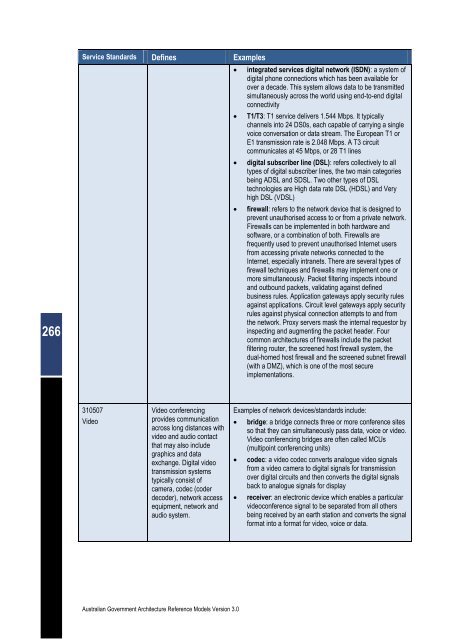Australian Government Architecture Reference Models Version 3.0
Australian Government Architecture Reference Models Version 3.0
Australian Government Architecture Reference Models Version 3.0
You also want an ePaper? Increase the reach of your titles
YUMPU automatically turns print PDFs into web optimized ePapers that Google loves.
266<br />
Service Standards Defines Examples<br />
310507<br />
Video<br />
Video conferencing<br />
provides communication<br />
across long distances with<br />
video and audio contact<br />
that may also include<br />
graphics and data<br />
exchange. Digital video<br />
transmission systems<br />
typically consist of<br />
camera, codec (coder<br />
decoder), network access<br />
equipment, network and<br />
audio system.<br />
<strong>Australian</strong> <strong>Government</strong> <strong>Architecture</strong> <strong>Reference</strong> <strong>Models</strong> <strong>Version</strong> <strong>3.0</strong><br />
� integrated services digital network (ISDN): a system of<br />
digital phone connections which has been available for<br />
over a decade. This system allows data to be transmitted<br />
simultaneously across the world using end-to-end digital<br />
connectivity<br />
� T1/T3: T1 service delivers 1.544 Mbps. It typically<br />
channels into 24 DS0s, each capable of carrying a single<br />
voice conversation or data stream. The European T1 or<br />
E1 transmission rate is 2.048 Mbps. A T3 circuit<br />
communicates at 45 Mbps, or 28 T1 lines<br />
� digital subscriber line (DSL): refers collectively to all<br />
types of digital subscriber lines, the two main categories<br />
being ADSL and SDSL. Two other types of DSL<br />
technologies are High data rate DSL (HDSL) and Very<br />
high DSL (VDSL)<br />
� firewall: refers to the network device that is designed to<br />
prevent unauthorised access to or from a private network.<br />
Firewalls can be implemented in both hardware and<br />
software, or a combination of both. Firewalls are<br />
frequently used to prevent unauthorised Internet users<br />
from accessing private networks connected to the<br />
Internet, especially intranets. There are several types of<br />
firewall techniques and firewalls may implement one or<br />
more simultaneously. Packet filtering inspects inbound<br />
and outbound packets, validating against defined<br />
business rules. Application gateways apply security rules<br />
against applications. Circuit level gateways apply security<br />
rules against physical connection attempts to and from<br />
the network. Proxy servers mask the internal requestor by<br />
inspecting and augmenting the packet header. Four<br />
common architectures of firewalls include the packet<br />
filtering router, the screened host firewall system, the<br />
dual-homed host firewall and the screened subnet firewall<br />
(with a DMZ), which is one of the most secure<br />
implementations.<br />
Examples of network devices/standards include:<br />
� bridge: a bridge connects three or more conference sites<br />
so that they can simultaneously pass data, voice or video.<br />
Video conferencing bridges are often called MCUs<br />
(multipoint conferencing units)<br />
� codec: a video codec converts analogue video signals<br />
from a video camera to digital signals for transmission<br />
over digital circuits and then converts the digital signals<br />
back to analogue signals for display<br />
� receiver: an electronic device which enables a particular<br />
videoconference signal to be separated from all others<br />
being received by an earth station and converts the signal<br />
format into a format for video, voice or data.

















